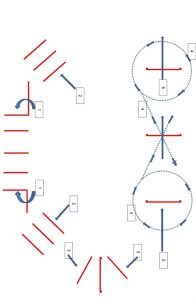Captain Richard Waygood, BE Performance Manager, training day.
Wednesday, 14th February at Wellington Riding, Hampshire
Valentines Day. What better day to spend quality time in the presence of Richard Waygood and venue host, David Sheerin along with good friends and colleagues.
This was a fully subscribed riding day, but also offering an excellent opportunity for spectators being allowed into the arena to be close up, watch & be involved in discussion & the questioning that develops between Richard and the riders.
We had been expecting grid work, of a long line of fences stretching up the 70 m long side of the fantastic Dukes Hall indoor school, but Richard had his own ideas for gymnastic type exercises.
He had 6 exercises set out, to ‘pump’ the horses up, get them ‘weight lifting’, activating the hind legs & finding their own better form of balance to improve their way of going.
 We started off using 5 trotting poles positioned off the track on the long side. At a 90* angle to be this on either end was another pole. Having familiarised the horses with the trot poles, Richard had us coming in over the right angle and then the following poles. This was a new exercise and certainly got the horses hocks flexing as they turned and in getting us to allow the horses a longer neck, they were able to find better balance themselves, even finding a ‘fifth’ leg, a theme that Richard kept coming back to through the session.
We started off using 5 trotting poles positioned off the track on the long side. At a 90* angle to be this on either end was another pole. Having familiarised the horses with the trot poles, Richard had us coming in over the right angle and then the following poles. This was a new exercise and certainly got the horses hocks flexing as they turned and in getting us to allow the horses a longer neck, they were able to find better balance themselves, even finding a ‘fifth’ leg, a theme that Richard kept coming back to through the session.
We moved on to three canter poles diagonally off an inner track towards the corners involving a change of rein. Richard was absolute in the horses arriving there totally straight. The hind legs following the front legs. Rhythm, softness & straightness throughout the exercise, to landing to the leading leg away. Letting the horses find their natural way of going, us as riders waiting for the turn, without hurrying, or us letting them fall through the turn.
The next exercise was one we’d done previously, but with a twist.
A pole, upright, pole exercise on a curved line. Except that the upright was lower to the inside and higher to the outside. The bounce placing poles being closer to the upright on the inside and with a more generous distance on the outer. Echoing Chris Bartle’s ‘ride the inner mid line’, we corrected the positioning of the horses shoulders before and after the fence and made sure we had the correct forward canter before we got there.
I found my horse was jumping across the fence and almost rotating his shoulder to the lower inside of the upright. In discussion, along with the other spectator coaches and riders, Richard & I changed the pole to be higher on the inside and lower on the outside. My horse remained more upright, without ‘cheating’ the exercise. That’s what’s best about these days, is the ability we have as coaches and riders, to discuss and trial, to see what does and can work, with informed discussion in a supportive environment.
The next exercise was three uprights, two short strides, the middle being a plank, that could all be jumped in either direction.
Richard had us cantering a 10m circle around the upright at each end, making sure that the canter was active, in front of out leg and straight. Main problems demonstrated as having too much inside rein & not riding the horse around, to losing the quality & rhythm of the canter on the circle and the falling behind the leg and us having to ‘event rider’ chase it to the plank on an angle off the circle, when the horse had ‘stalled’ on us.
On landing, we were back onto the 10m circle around the other upright, coming again to the plank at an angle off the other rein. Richard encouraged us to circle as many times as needed to get the canter really active and responsive. Again priorities were in the straightness to the fence and allowing the horse to use his neck & our maintenance of the canter that we’d created throughout the circle exercise.
Once we’d achieve this, we jumped down through the whole exercise, a treble of short two strides, but with the emphasis on the horse working over his back, in a good forward canter, on the long and short sides prior to meeting the first element.
Richard’s main aim was to enable the horses to stay in rhythm & not to gain ground down it. Riders needed to stay upright, as excessive folding encouraged the horses to hollow, rush, or gain too much distance. The horses were allowed to ‘back themselves up’ and good jumps followed.
All the time, reminding us that a good balanced canter gave us options, to shorten, or lengthen to the first fence. We repeated it, off both reins, with Richard helping us recognise what had happened in previous exercises and what needed to happened now to improve the initial approach. Looking for the attention, focus and relaxation, so encouraging the horse to become more rideable, allowing us to put more leg on, so we could more forwards to the fence.
As a finale, we jumped the last element off the track, as a larger oxer, the emphasis in changing nothing and letting our horses come in the rhythm and balance we’d previously worked on creating.
The usual amazingly tasty Wellington Farm Shop Buffet was on offer at lunch time, where we can have some ‘down time’ together to catch up, discuss how we felt we’d ridden and our horses had gone along with a bit of banter and this year included the giving of Valentines cards and mugs to Richard and David. Immediate recycling at its best, as both declared, that they hadn’t got their partners anything in advance!
These days are time well spent on us, for our horses and also for us as coaches.
A huge thank you to David Sheerin for organising the day & Richard Waygood for great coaching and tools for us to take away. I’m looking forward to the F&I camp at Wellington Riding, in June already.
There are some fabulous video clips of the day, that David took, on the F&I Facebook page, showing all of the exercises, thoughts and reflections, as well as those attached here.
Report by Sarah Thorne.
